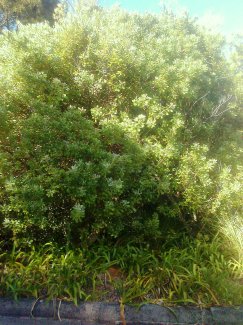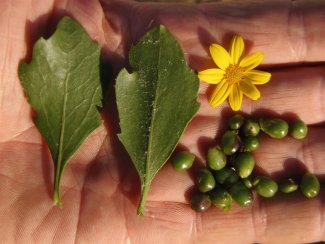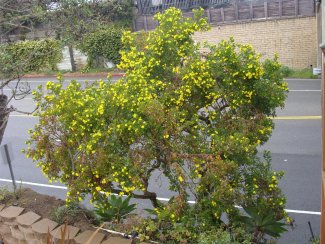southern and southeastern coastal areas of South Africa
South Africa - Eastern Cape, - Western Cape
An evergreen flowering shrub or small tree, usually with woolly, dull, serrate, oval leaves, but with glossy round leaves in the subsp. rotundata, belonging to the Asteraceae (daisy) family. Boneseed is a perennial, woody, upright shrub, growing to 3 m (9.8 ft), although occasionally taller. It is a member of the Asteraceae (daisy) family and has showy, bright yellow flowers in swirls of 5-8 'petals' (ray florets) up to 30 mm (1.2 in) in diameter. Fruit are berry-like, spherical at around 8 mm in diameter, and turn dark-brown to black with a bone-coloured seed inside of 6–7 mm diameter. Leaves are 2–6 cm (0.79–2.36 in) long by 1.5–5 cm (0.59–1.97 in) wide, oval tapering to the base with irregularly serrate margins. Bitou bush (ssp. rotundata) is a perennial, evergreen shrub, normally 1–2 m high although it can form canopies up to 10 m high. Unlike its close relative boneseed (Chrysanthemoides monilifera ssp. monilifera), which grows as an erect bush, bitou bush is a sprawling shrub.
Naturalized in California, and on Cal-IPC's watchlist, but not sold as an ornamental. Bitou bush (ssp. rotundata) was first recorded in Australia near Newcastle, New South Wales, about 1908, probably introduced through dumping of ships’ ballast. From 1946 to 1968 it was planted along the coast to revegetate areas after sandmining. It was also planted on sand dunes near Menindee in western New South Wales where a small infestation still persists. Boneseed (Chrysanthemoides monilifera subsp. monilifera) was deliberately cultivated as a beach and sand stabiliser, and also as a garden ornamental, in the past. The species was first imported into the United States (as Osteospermum moniliferum) in 1912 (USDA Bureau of Plant Industry, 1914). U.S. distribution and status: Chrysanthemoides monilifera subsp. monilifera was introduced into California (Palomar College, San Diego County) around 1980 and has naturalized in nearby coastal sage scrub hills (Armstrong, 2000; Jepson Flora Project (eds.), 2013 - USDA WRA). This plant has been recently discovered spreading from a single population in Orange County.



